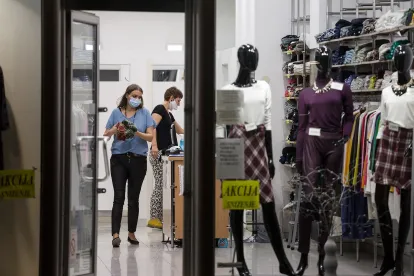RETAIL INDUSTRY 2021 YEAR IN REVIEW
Employers who hoped that 2021 would bring more consistent—and consistently reliable—requirements and guidance on COVID-19 risk mitigation measures than we had in 2020 were disappointed. 2021 was every bit as confounding as 2020. The first half of 2021 saw a mad rush for vaccinations, which suggested the final US vaccination percentages would be high. By fall, however, it was clear that the vaccine-reluctant would be hard to persuade to change their minds. Government and private employers tried “carrot” approaches—prizes, bonuses and health premium reductions to name a few—and “stick” approaches, primarily vaccine mandates. The “carrots” were not attractive enough and vaccine mandates caused an avalanche of religious reasonable accommodation requests overwhelming employers’ human resources departments. This set the stage for President Biden’s Executive Order 14042, “Ensuring Chasing Compliance—A Year of Uncertainty in COVID-19 Workplace Safety Law Adequate COVID Safety Protocols for Federal Contractors” (the EO) and the Occupational Safety and Health Administration’s COVID-19 Vaccination and Testing Emergency Temporary Standard (the ETS). The EO and the ETS were announced as vaccine mandates. However, both included reasonable accommodation carve-outs for vaccine mandates and the ETS permitted employers to use the option of weekly testing or vaccination. Employers covered by the EO did not have to follow the ETS. All private employers with 100 or more employees who were not covered by the EO had to follow the ETS.
Employers had difficulty divining the manner in which these legal requirements would meaningfully change vaccination percentages. The ETS vaccine-or-test requirement appeared to incentivize vaccination because the ETS provided that employees would have to pay for the cost of any COVID tests. But, employees only would be obligated to pay if no other legal requirements conflicted. Many states have potentially applicable laws that require employers to pay for mandatory medical tests. Unions were predictably unwilling to agree to employee payment requirements. And, in December, the administration announced new HHS rules that would require health plans to pay for up to eight COVID-19 tests per month, none of which could be used to comply with employer COVID-19 testing. As such, employers who sponsor self-insured plans would end up paying for 12 tests per month (eight through the health plan and then four for the weekly tests). To avoid legal risk, employers also needed to treat time spent testing as compensable under federal and state wage-and-hour laws. In the end, the employee who was supposed to be incentivized to vaccinate was going to receive free testing and additional straight time and potentially overtime pay each testing week.
The EO is mired in litigation and the Supreme Court of the United States stayed the ETS. Because an ETS can only remain in place for six months under the OSH Act, the Supreme Court stay likely kills the rule for all practical purposes. The decision sends the challengers’ case back to the Sixth Circuit for a full decision on the merits of whether the law is enforceable. That process will likely take months and cause the enforcement period for the ETS to expire. Meanwhile, some states and localities passed their own COVIDrelated rules both pro-vaccination and anti-vaccination. As employers enter Year three of the pandemic, the compliance landscape remains almost as murky as in Year one.
Where does that leave employers? Despite the stay, OSHA has other avenues to enforce COVID-19–related requirements in the workplace. OSHA has announced it intends to enforce COVID-19 regulations through its General Duty Clause. Under the General Duty Clause, OSHA can cite employers if they fail to provide a workplace free from recognized hazards that are causing or are likely to cause death or serious physical harm. If employers ignore or fail to follow COVID-19 guidance from OSHA or the CDC, OSHA may allege the employers failed to protect employees from the recognized hazard of COVID-19. Before the ETS, OSHA issued citations to a number of employers on just these grounds. To facilitate this end, OSHA is likely to issue new general and industry-specific COVID-19 guidance, as their current guidance is outdated in some respects.
OSHA also previously issued a National Emphasis Program (NEP) for COVID-19 that applies to certain industries, including supermarkets, discount department stores and restaurants. Under the NEP, OSHA will perform a greater number of programmed inspections at these target employers for COVID-19 violations. OSHA’s basis for citation will be the same—the General Duty Clause and other applicable standards such as those for personal protective equipment. The NEP permits OSHA to conduct an inspection at any time at any NEP-covered workplace. States and localities also will continue to fill the enforcement void left by the ETS.
Under the State Plan structure, 21 states have the ability to adopt their own workplace safety standards against private employers so long as those rules are at least as effective as the federal OSHA standards. This can be done through a state emergency temporary standard or a permanent rule. For example, the California Occupational Safety and Health Standards Board issued a California ETS that governs mask and testing standards. Similarly, the Virginia Department of Labor and Industry adopted its own permanent COVID-19 workplace safety standard, much of which goes beyond what federal OSHA has required. In addition, cities like New York, Washington, DC, Chicago and Los Angeles have enacted their own rules for employers within their borders.
Inconsistent and constantly changing legal requirements can distract from the key focus, which remains keeping workers safe and healthy. Retail employers have been focused on that goal throughout the pandemic. And, subject to state law, employers remain free to set their own COVID-19 workplace policies including vaccination mandates, testing, distancing and face mask requirements. Employers should continue to follow OSHA and CDC updates and incorporate them into their policies. In the event of an OSHA investigation, solid compliance with these guidelines should prevent citation and, ideally, also minimize the disruption of COVID-19 to the workplace.
Steve DiBeneditto also contributed to this article.





 />i
/>i

